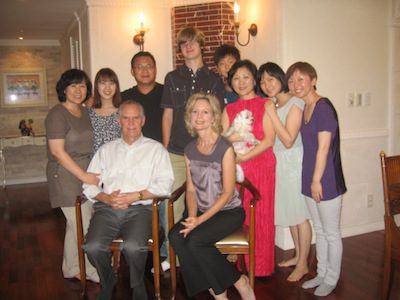
22 Aug 2011 A foodie goes to Asia
by Kellie Dye
If you search the word “foodie” on the internet, you’ll see it described as a person having an enthusiastic interest in the preparation and consumption of good food. A foodie is not a food snob who is only interested in eating the very best food. A foodie loves to eat most any food, but also wants to know interesting facts about food. Where does this food originate from? How is it prepared?
Foodies are more than curious. They have a real appreciation for food that extends beyond taste. I call myself a foodie, but not a food snob. I can appreciate a good potato chip as well as a perfectly cooked dish of risotto.
This foodie recently returned from an amazing trip with my husband, Steve, and son, Ian Turpin, to Tokyo, JeJu Island and Seoul. Many people travel abroad seeking beautiful scenery and cultural landmarks. Sure, that’s fun, but quite honestly I go for the food!
My main goal while we were there was to only eat what the locals eat. In other words, NO American food. I’m proud to report that I did not succumb once; however, I can’t say the same for my 15-year-old who by my estimate lost about 5 pounds during our quest to avoid all American food.

After he tried to exist on white rice and Coca Cola for several days, the nutritionist and mother in me finally relented when we spotted a Subway restaurant in Tokyo. Trying to order a sub sandwich with specific ingredients in Japanese was a bit daunting, but finally my son had some protein. If you have a teenager who is a picky eater, you could always bring him or her to an exotic country and when they get hungry enough, they will actually try a new food. He did manage to try assorted sushi, soups and even tofu.
While in Japan we ate a variety of noodles, tempura and of course sushi and sashimi. Tokyo has one of the world’s largest fish markets. To me the fish market was one of the most exciting places (only a foodie would say that). Eating fresh sashimi at the Tokyo fish market was a dream come true – even if it was at breakfast time.
The island of JeJu is off the coast of Korea. They call it the “Hawaii of Korea.” It was breathtakingly beautiful, and the area is known for its tangerines, black pork and again, sushi.
Our tour guide was very pleased to learn of our no American food quest, and she took full opportunity to take us to only local restaurants. The tangerines were incredibly sweet and delicious. It was there that I fell in love with the traditional Korean dish of Bibimbap, which is a hot, sizzling bowl of rice, spicy vegetables and hot sauce with a soft cooked egg on top. You mix it all together, and the flavors meld perfectly. Every place we dined offered so many vegetable side dishes, various soups, seaweed salads and of course kimchee, which is a spicy pickled cabbage.
Once in the city of Seoul in South Korea, we were introduced to real Korean barbecue always prepared at the table. Again there were so many side dishes (we counted no less than 40 dishes on our table at each meal). It surprised me that rice or noodles were always served at the end of the meal. Once you fill up on vegetable dishes and meat, there is little room for starch.
I noticed so many interesting things about the food culture in Asia. For example, soda is hard to find, and when you order it in a restaurant, you get a very small bottle. There are no refills or seconds. There are many “soda machines,” but they are full of assorted water and teas, not much soda. Meat is not the main focus – vegetables are. People don’t walk around eating or drinking.
Children begin using chopsticks at the age of 3. And yes, it is possible to get used to chopsticks, especially when you are hungry and the food is extra delicious.
Bibimbap 2 tsp. low sodium soy sauce
1 tsp. minced peeled fresh ginger
1 garlic clove, minced
4 oz. lean beef, thin sliced (you may also use
chicken, turkey or pork instead)
1 cup matchstick sliced carrots
1 cup thinly sliced mushrooms
1 cup fresh spinach
1 cup matchstick sliced and peeled seedless
cucumber
1/2 tsp. toasted sesame seeds
1/2 tsp. rice vinegar
1/8 tsp. salt
1/8 tsp. sesame oil
1 garlic clove, minced
4 large eggs
1/4 tsp. salt
3 cups cooked rice
4 tsp. Thai chile paste
Combine the first four ingredients in a plastic Ziploc bag. Seal and marinate in the refrigerator for about 30 minutes. Heat a nonstick skillet and spray with cooking spray. Add the beef mixture plus the carrots, mushrooms and spinach and stirfry for 3-5 minutes, remove and keep warm. Combine the cucumber and the next five ingredients and set aside.
Heat the skillet, spray with cooking spray. Cook each egg over-easy to desired doneness. Remove eggs and keep warm.
Spoon 3/4 cup of rice into four bowls. Divide up the beef/carrot mixture onto the four bowls of rice. Top each bowl with the egg plus 1 tsp. of Thai chile paste. (You can also add Siracha Hot Chile Sauce for a spicier kick.)
Makes 4 servings: 374 calories, 8 grams of fat, 51 grams of carb, 6 grams of fiber, 699 mg sodium.











